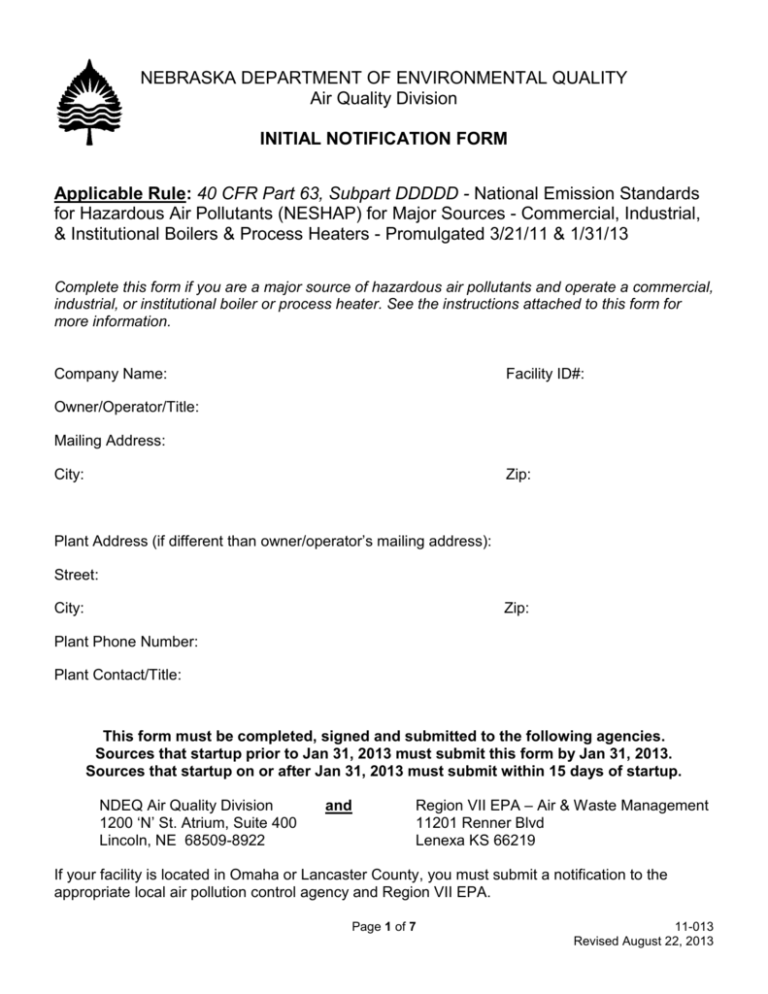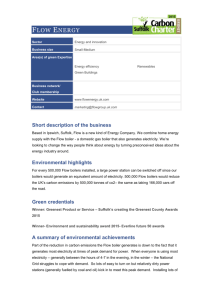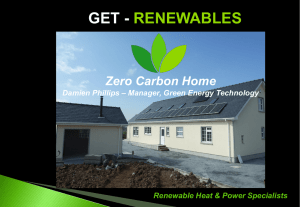Initial Notification Form - Nebraska Department of Environmental
advertisement

NEBRASKA DEPARTMENT OF ENVIRONMENTAL QUALITY Air Quality Division INITIAL NOTIFICATION FORM Applicable Rule: 40 CFR Part 63, Subpart DDDDD - National Emission Standards for Hazardous Air Pollutants (NESHAP) for Major Sources - Commercial, Industrial, & Institutional Boilers & Process Heaters - Promulgated 3/21/11 & 1/31/13 Complete this form if you are a major source of hazardous air pollutants and operate a commercial, industrial, or institutional boiler or process heater. See the instructions attached to this form for more information. Company Name: Facility ID#: Owner/Operator/Title: Mailing Address: City: Zip: Plant Address (if different than owner/operator’s mailing address): Street: City: Zip: Plant Phone Number: Plant Contact/Title: This form must be completed, signed and submitted to the following agencies. Sources that startup prior to Jan 31, 2013 must submit this form by Jan 31, 2013. Sources that startup on or after Jan 31, 2013 must submit within 15 days of startup. NDEQ Air Quality Division 1200 ‘N’ St. Atrium, Suite 400 Lincoln, NE 68509-8922 and Region VII EPA – Air & Waste Management 11201 Renner Blvd Lenexa KS 66219 If your facility is located in Omaha or Lancaster County, you must submit a notification to the appropriate local air pollution control agency and Region VII EPA. Page 1 of 7 11-013 Revised August 22, 2013 SOURCE DESCRIPTION 1. Provide the following information for each affected boiler and process heater. Add additional tables or rows as needed. Unit #1 Emission Unit Name (design and manufacturer name) Existing or New2 Rated Heat Input Capacity (MMBtu/Hr)3 All Fuels Used4 Existing New Existing New Existing New Existing New 1 If the source has an air permit, use the IDs that are consistent with those reported in the permit. 2 New source means that you commenced construction or reconstruction of the boiler after June 4, 2010 and you meet the applicability criteria at the time you commence construction. Existing source means you commenced construction or reconstruction of the boiler on or before June 4, 2010. 3 mmBtu/hr refers to million British thermal units per hour. Boilers and process heaters often have a nameplate listing the rated heat input capacity on the unit. This rated capacity may have also been reported to the entity insuring the boiler or process heater for the state labor and safety inspector. 4 Report all fuels used in each of the units subject to the standard (e.g., bituminous coal, #6 fuel oil, #2 fuel oil, natural gas, bark, lumber, etc.). 2. Optional: Additional notes 3. My facility is a (please choose one): Major source Area source If your facility is an area source of hazardous air pollutants (HAP), please refer to the National Emission Standards for Hazardous Air Pollutants for Area Sources: Industrial, Commercial, and Institutional Boilers, 40 CFR Part 63 Subpart JJJJJJ at http://deq.ne.gov/Airtoxic.nsf/pages/JJJJJJ. Page 2 of 7 11-013 Revised August 22, 2013 CERTIFICATION Print or type the name and title of the Responsible Official for the facility: Name: Title: A Responsible Official can be: The president, vice president, secretary, or treasurer of the company that owns the plant; An owner of the plant; A plant engineer or supervisor of the plant; A government official, if the plant is owned by the Federal, State, City, or County government; or A ranking military officer, if the plant is located at a military base. I CERTIFY THAT INFORMATION CONTAINED IN THIS REPORT IS ACCURATE AND TRUE TO THE BEST OF MY KNOWLEDGE. __________________________________________ (Signature of Responsible Official) Page 3 of 7 (Date) 11-013 Revised August 22, 2013 NESHAP Subpart DDDDD – Initial Notification Form Instructions What is the purpose of this form? You may use this form to meet the requirements for submitting an initial notification under National Emission Standards for Hazardous Air Pollutants (NESHAP) for Industrial, Commercial, and Institutional Boilers and Process Heaters Major Sources (40 CFR Part 63, Subpart DDDDD). However, you may submit the information in another form or format. Am I required to submit an Initial Notification? You must submit an Initial Notification if you are subject to NESHAP Subpart DDDDD. Major source means any stationary source or group of stationary sources located within a contiguous area and under common control that emits or has the potential to emit considering controls, in the aggregate, 10 tons per year or more of any hazardous air pollutant or 25 tons per year or more of any combination of hazardous air pollutants1, unless the Administrator establishes a lesser quantity, or in the case of radionuclides, different criteria from those specified in this sentence (§63.2). Area source means any stationary source of hazardous air pollutants1 that is not a major source (§63.2). Am I subject to NESHAP Subpart DDDDD? You are subject to NESHAP Subpart DDDDD if you own or operate an industrial, commercial, or institutional boiler that is located at, or is part of, a major source of hazardous air pollutants (HAP). Boiler means an enclosed device using controlled flame combustion and having the primary purpose of recovering thermal energy in the form of steam or hot water. Controlled flame combustion refers to a steady-state, or near steady-state, process wherein fuel and/or oxidizer feed rates are controlled (§63.7575). A device combusting solid waste, as defined in §241.3, is not a boiler unless the device is exempt from the definition of a solid waste incineration unit as provided in section 129(g)(1) of the Clean Air Act. Commercial/institutional boiler means a boiler used in commercial establishments or institutional establishments such as medical centers, research centers, institutions of higher education, hotels, and laundries to provide steam and/or hot water. Industrial boiler means a boiler used in manufacturing, processing, mining, and refining or any other industry to provide steam and/or hot water. Process heater means an enclosed device using controlled flame, and the unit's primary purpose is to transfer heat indirectly to a process material (liquid, gas, or solid) or to a heat transfer material for use in a process unit, instead of generating steam. Process heaters are devices in which the combustion gases do not come into direct contact with process materials. A device combusting solid waste, as defined in §241.3, is not a process heater unless the device is exempt from the definition of a solid waste incineration unit as provided in section 129(g)(1) of the Clean Air Act. Page 4 of 7 11-013 Revised August 22, 2013 Which boilers are not subject to NESHAP Subpart DDDDD (§63.7491)? The types of boilers and process heaters listed below are not subject to subpart DDDDD. For more information, see § 63.7575, “What definitions apply to this subpart?”: (1) Hot water heater. If you have a closed vessel with a capacity of no more than 120 U.S. gallons in which water is heated by combustion of gaseous or liquid fuel and is withdrawn for use external to the vessel at pressures not exceeding 160 pound-force per square inch gauge (psig), including the apparatus by which the heat is generated and all controls and devices necessary to prevent water temperatures from exceeding 210 degrees Fahrenheit (99 degrees Celsius). Many hot water heaters at an affected source that are used to heat bathroom or dishwashing water have capacities no more than 120 U.S. gallons and meet this exemption (see §63.7491(d)). (2) Waste heat boiler means a device that recovers normally unused energy and converts it to usable heat. Waste heat boilers are also referred to as heat recovery steam generators. (3) Autoclaves or process heaters that are used to provide comfort heat, space heat, or food preparation for on-site consumption. (4) Electric utility steam generating unit means a fossil fuel-fired combustion unit of more than 25 megawatts that serves a generator that produces electricity for sale. (see §63.7491(a)). (5) Boilers subject to other NESHAP standards. If the boiler is specifically listed as, or included in the definition of, an affected source in another standard(s) under part 63 (see §63.7491(h)). For example, a process heater used to control the temperature and humidity of the air in a paint spray booth (which is covered under subpart IIII, subpart PPPP, or subpart MMMM of part 63) would not be subject to this rule. (6) Boilers that are used as control devices for other NESHAP standards. If the boiler is used as a control device for another process that is subject to part 63 and at least 50 percent of the heat input to the boiler or process heater is provided by the gas stream that is regulated under another subpart the unit is exempt from this rule (see §63.7491(i)). The HON and MON rules (subparts G and FFFF of part 63) regulate process vent streams that may be controlled by boilers or process heaters where the majority heat input is provided by these regulated process vent streams. (7) Research and Development boilers. If the boiler is used specifically for research and development it is exempt; for example, many universities or boiler manufacturers may have test boilers to develop new designs or combustion modifications. This exemption does not include boilers that solely or primarily provide steam (or heat) to a process or for heating at a research and development facility. This exemption does not prohibit the use of the steam (or heat) generated from the boiler during research and development, however, the boiler must be concurrently and primarily engaged in research and development for the exemption to apply (see §63.7491(c)). (8) Temporary boilers. Any gaseous or liquid fuel boiler that is designed to, and is capable of, being carried or moved from one location to another. A boiler is not a temporary Page 5 of 7 11-013 Revised August 22, 2013 boiler if any one of the following conditions exists: a) The equipment is attached to a foundation. b) The boiler or a replacement remains at a location for more than 12 consecutive months. Any temporary boiler that replaces a temporary boiler at a location and performs the same or similar function will be included in calculating the consecutive time period. c) The equipment is located at a seasonal facility and operates during the full annual operating period of the seasonal facility, remains at the facility for at least 2 years, and operates at that facility for at least 3 months each year. d) The equipment is moved from one location to another in an attempt to circumvent the residence time requirements of this definition (see §63.7491(j)). (9) A recovery boiler or furnace covered by 40 CFR part 63 subpart MM (see §63.7491(b)). (10) A refining kettle covered by 40 CFR part 63 subpart X (see §63.7491(e)). (11) An ethylene cracking furnace covered by 40 CFR part 63 subpart YY (see §63.7491(f)). (12) Blast furnace stoves as described in the EPA document, entitled National Emission Standards for Hazardous Air Pollutants (NESHAP) for Integrated Iron and Steel Plants—Background Information for Proposed Standards, Final Report, EPA–453/R– 01–005, January 2001 (see: http://www.epa.gov/ttn/oarpg/t3/reports/irnstlbid.pdf and §63.7491(g)). (13) Blast furnace gas fuel-fired boilers and process heaters (see §63.7491(k)). (14) Boilers subject to section 129 of the Clean Air Act. If the boiler is specifically listed as an affected source in another standard(s) under section 129 (e.g., Hospital/Infectious Medical Waste Incinerators, Commercial/Industrial Solid Waste Incinerators, Sewage Sludge Incinerators) (see §63.7491(l)). (15) Hazardous Waste Boilers. A boiler required to have a permit under section 3005 of the Solid Waste Disposal Act or if the boiler is covered by 40 CFR part 63 subpart EEE (see §63.7491(m)). When must I submit an Initial Notification (§63.9(b)(2))? Sources with a startup date prior to Jan 31, 2013 must submit notification by May 31, 2013. Sources with a startup date on or after Jan 31, 2013 must submit notification within 15 days of startup. Is my source a new or existing source (§63.7490 (b), (c))? New source means that you commenced construction or reconstruction of the boiler or process heater after June 4, 2010 and you meet the applicability criteria at the time you commence construction. Existing source means you commenced construction or reconstruction of the boiler or process heater on or before June 4, 2010. Page 6 of 7 11-013 Revised August 22, 2013 To whom do I submit the initial notification? NDEQ Air Quality Division 1200 ‘N’ St. Atrium, Suite 400 Lincoln, NE 68509-8922 and Region VII EPA – Air & Waste Management 901 N. 5th Street Kansas City, KS 66101-2907 If your facility is located in Omaha or Lancaster County, you must submit a notification to the appropriate air pollution control agency in that area and Region VII EPA. What are my compliance dates (§63.7495)? Existing Sources must comply with all requirements of the rule by Jan 31, 2016. New sources must comply with all requirements of the rule by Jan 31, 2013, or upon startup, whichever is later. Where can I find more information? More information and guidance can be found on the NDEQ Air Toxics Notebook located at http://deq.ne.gov/Airtoxic.nsf/pages/DDDDD. You can also find the page by going to the NDEQ website at http://deq.ne.gov and selecting “Focus on Air.” EPA’s boiler website can be found at www.epa.gov/ttn/atw/boiler/boilerpg.html. You may also contact the NDEQ Air Toxics Coordinator at (402) 471-2189 or NDEQ.AirQuality@nebraska.gov. Page 7 of 7 11-013 Revised August 22, 2013








